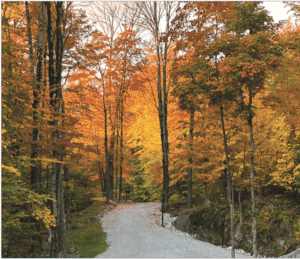By Julia Purdy
Well, fall foliage has done it again… in spite of a slow start and drought that has hit some trees hard, Indigenous Peoples’ Weekend (formerly Columbus Day) rewarded visitors and locals like with the progression of color that, like an orchestra tuning up, began gradually as one species after another reacted to changes in daylight and temperature, and lit up the hills and valleys with a psychedelic light show.

Yellow and orange leaves appear to glow as the sun puts a spot light on a patch in Killington.
Only about one-third of the continental U.S. is deciduous forest, from the Canadian border to the Gulf of Mexico. Vermont is favored with the northern hardwood forest, which includes slow-growing timber trees such as the maples, beech, ash, basswood, and the oaks. Deciduous softwoods include fast-growing poplar, aspen and birch.
In the Northern Hemisphere, leaves turn color the world round, from Japan to Australia, Europe to Russia, wherever deciduous broadleaf species grow. About 7% of the Northern Hemisphere is covered with temperate deciduous forest, either wild or in managed plantations. And as the flavors of fine wines are influenced by terroir — the soils and climate of certain regions – so certain tree species are identified with various parts of the world. England has its oaks, Italy and France are known for poplars and beech forests, Germany for beech and oak; Japan is most familiar for its ornamental maple but the country also is host to birch, ash and varieties of oak. Russian deciduous forests would look familiar to us with their white birch stands, golden-red maple trees and oaks.
The sheer diversity of deciduous forest trees in Vermont may account for the incandescence of fall color as well as the state’s worldwide reputation for never-fail foliage viewing. Why Vermont in particular? Well, 78% of Vermont is covered by forest, with 71% of that consisting of a mix of maple-beech-birch natural communities and other colorful species — dramatic fall foliage is a given.
The first bursts of scarlet belong to the red maple, followed by the softwoods: the poplars, birches and aspens that twinkle in tones of clear yellow and light gold, and beech that ripens from dark gold to toasty brown. Larch or tamarack, also deciduous, has fine tufts of “needles” that turn the tree into a golden pillar. The tree that everyone eagerly awaits is the sugar maple, which might offer up golden yellow, a peachy-blush or crimson, depending on both sunlight and glucose content in the leaves. Soon to follow is the ash, going from greenish bronze to purple. The stout oaks bring up the rear, providing variegated leaves that turn burgundy or russet. By the time most foliage color has emerged, a richly diversified hillside resembles a Royal Stewart tartan blanket.
A forester friend once remarked that even if foliage season seems early or late, it always ends up on time. This is because of all the variables – weather, soil, nutrients, rainfall, exposure – the one constant is the loss of light, which in the Northern Hemisphere brings cold temperatures. In addition, for every 1,000 feet in elevation, the average annual temperature drops about 4 degrees. It is helpful to think of deciduous trees as perennial plants, which go into dormancy to survive winter. Healthy deciduous broadleaf trees generally lose their leaves in the order by which they come into color. As the days shorten and nights get colder, trees stop doing photosynthesis and withdraw green chlorophyll from their leaves, revealing the latent pigments of yellow-orange-brown (carotenoids) and red (anthocyanin). At the same time, to conserve moisture, the tree seals the joint where the leaf stem joins the twig. When this process is complete, the leaf falls away. Many trees begin the process in the outermost limbs and treetops, which may flame while the rest of the tree is still green. In unhealthy trees or those stressed by drought, for example, the process is accelerated, explaining why some leaves —even maples — turn brown and drop early. But the beeches often let their leaves wither on the twig to a paper-like texture that shivers and rustles in the wind and adds a grace note to the stark winter woods.
Some may lament the appearance of bare spots in the hillsides and the arrival of “stick season” with its dreary days. It helps to remember that the trees are also preparing for the return of spring.




